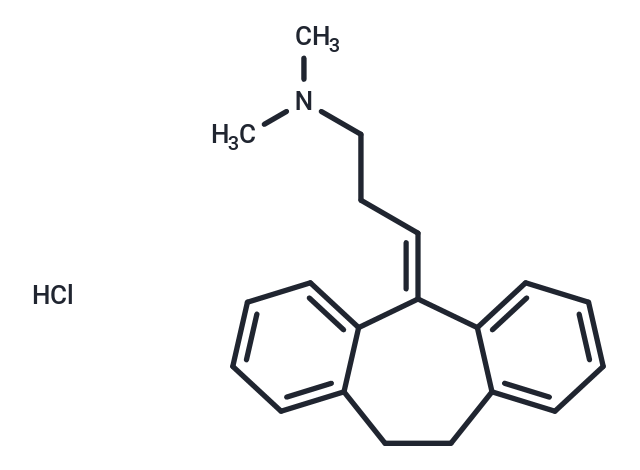Shopping Cart
- Remove All
 Your shopping cart is currently empty
Your shopping cart is currently empty


| Pack Size | Price | Availability | Quantity |
|---|---|---|---|
| 500 mg | $45 | In Stock | |
| 1 g | $53 | In Stock |
| Description | Amitriptyline hydrochloride (Annoyltin) is the hydrochloride salt of the tricyclic dibenzocycloheptadiene amitriptyline with antidepressant and antinociceptive activities. |
| Targets&IC50 | 5-HT receptor:3.45 nM, Norepinephrine receptor:13.3 nM, 5-HT4:7.31 nM, 5-HT2:235 nM, σ1 receptor:287 nM |
| In vitro | Amitriptyline inhibits Forskolin-stimulated cyclic AMP accumulation with EC50 values of 16.2 μM in intact CHO/DOR cells. Amitriptyline causes a concentration-dependent stimulation of ERK1/2 and GSK-3β phosphorylation with EC50 values of 9.0 μM in CHO/DOR cells. Amitriptyline (15 μM) causes a stimulation of ERK1/2 phosphorylation in C6 cells. Amitriptyline (30 μM) inhibits Forskolin-stimulated adenylyl cyclase activity and antagonizes ( )-U50,488 inhibitory effect in rat nucleus accumbens. [5] Amitriptyline binds the extracellular domain of both TrkA and TrkB and promotes TrkA-TrkB receptor heterodimerization. Amitriptyline (< 500 nM) promotes TrkA autophosphorylation in primary neurons and induces neurite outgrowth in PC12 cells. Amitriptyline selectively protects T17 cells from apoptosis with EC50 of 50 nM. [6] |
| In vivo | Amitriptyline (15 mg/kg, i.p.) activates TrkA and TrkB receptors and significantly reduces kainic acid-triggered neuronal cell death in mice. [6] Amitriptyline (15 mg/kg and 30 mg/kg, i.p.) dose-dependently decreases the immobility time in the forced swimming test (FST) of mice. Amitriptyline (15 mg/kg, i.p.) shows a significant 24-h rhythm in the immobility time in the forced swimming test (FST) of mice. [7] Amitriptyline (1 mg/kg and 3 mg/kg) significantly increases the total distance travelled of mice in novel cages. Amitriptyline (10 mg/kg p.o., twice daily) considerably attenuates the hypothermic response to 8-OHDPAT and mCPP in mice. Amitriptyline (10 mg/kg p.o., twice daily) significantly reduces serotonin transporter density by approximately 20% in cortex of mice. [8] |
| Alias | Tryptizol, Domical, Annoyltin, Amitriptyline HCl |
| Molecular Weight | 313.86 |
| Formula | C20H24ClN |
| Cas No. | 549-18-8 |
| Storage | Powder: -20°C for 3 years | In solvent: -80°C for 1 year | Shipping with blue ice. | ||||||||||||||||||||||||||||||||||||||||
| Solubility Information | DMSO: 50 mg/mL (159.31 mM), Sonication is recommended. H2O: 12 mg/mL (38.2 mM) Ethanol: 59 mg/mL (188 mM) | ||||||||||||||||||||||||||||||||||||||||
Solution Preparation Table | |||||||||||||||||||||||||||||||||||||||||
H2O/DMSO/Ethanol
DMSO/Ethanol
| |||||||||||||||||||||||||||||||||||||||||

Copyright © 2015-2024 TargetMol Chemicals Inc. All Rights Reserved.